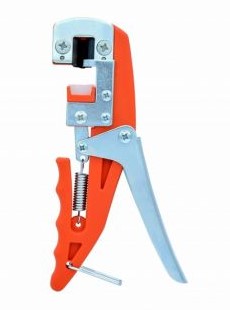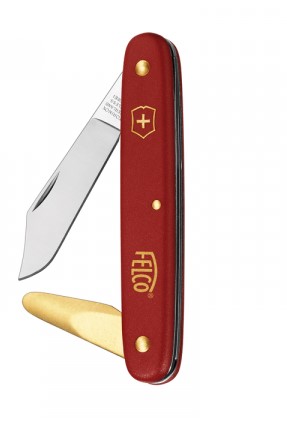Using grafting forceps
What is grafting
Plant grafting is a horticultural technique that involves fusing part of a plant, called the scion, with another plant, called the rootstock. The aim of this operation is to combine the desired characteristics of the scion (such as flowering, fruiting or disease resistance) with the qualities of the rootstock, such as vigor, resistance to soil conditions or pests.
What are the different types of graft ?
The most commonly used grafts depend on the type of plant, the purpose of the graft and the growing conditions. Here are the most frequently used grafting techniques :
Slot grafting is a simple and widely used method, particularly for fruit and ornamental trees. Loop grafting, also known as escutcheon grafting, is very popular for fruit trees, especially citrus, roses and vines. Crown grafting is used for fruit trees and certain ornamental plants. Bud grafting is often used for vines, fruit trees and shrubs. Cleft grafting, also known as wedge grafting, is often used for fruit trees with large trunks, such as apple and pear trees.
What are grafting pliers ?
To carry out a plant graft, you'll need grafting forceps.
A grafting forceps is a tool specially designed to facilitate the process of grafting plants. It is used to make precise, clean cuts when preparing the graft and rootstock. The grafting forceps are designed to minimize damage to plant tissue, thus promoting grafting success.
The features of a grafting forceps may vary according to the type of graft and the grafter's preferences, but generally they include:
- A sharp blade: Grafting forceps are equipped with a sharp blade for making clean cuts, essential for ensuring rapid and successful healing.
- Adapted shape: Depending on the type of graft (cleft, escutcheon, cleft, etc.), the shape of the forceps can vary to facilitate the specific cut required for the chosen grafting technique.
- Ergonomic handles : Grafting forceps handles are often ergonomically designed to ensure a comfortable grip and reduce grafter fatigue during prolonged use.
- A locking mechanism : Some grafting forceps feature a locking mechanism that keeps the blade closed when not in use, ensuring the grafter's safety.
- Quality materials : Grafting forceps are generally made from quality materials, such as stainless steel, to ensure durability and corrosion resistance.

- How do grafting forceps work ?
What are the different steps involved in grafting ?
Here's a general description of how a grafting forceps works by step :
- Preparing the graft and rootstock: Before using the grafting tool, the grafter prepares the graft (the part of the plant to be grafted) and the rootstock (the plant that will receive the graft). This often involves pruning the two parts to create surfaces conducive to fusion.
- Gripping the forceps: The grafter grips the forceps so as to have precise control over the tool. Ergonomic gripping handles provide a comfortable grip.
- Blade positioning: Depending on the type of graft, the grafter positions the forceps blade to make a specific cut. For example, for a slit graft, the blade would be positioned to create a vertical slit.
- Precise cut: By pressing down on the gripper handles, the grafter makes a clean, precise cut on the graft or rootstock. The quality of the cut is crucial, as clean cuts promote rapid healing and tissue fusion.
- Repeating the process: The grafter repeats the cutting process on the graft and rootstock according to the grafting technique chosen. Precise, well-fitting cuts are essential to maximize the graft's chances of success.
- Assembling the parts: Once the cuts have been made, the grafter assembles the graft and the rootstock. The two parts must be correctly aligned and in close contact to promote tissue fusion.
- Tying or ligation: Depending on the type of graft, the grafter may use grafting tape to hold the grafted parts in place during the healing process.
Precautions to take ?
When grafting, certain precautions must be taken to ensure the success of the graft and the safety of the grafter.
First of all, choose healthy, vigorous plants to use as rootstocks and scions. Avoid using weakened, diseased or pest-infested plants. Next, make sure that tools, including grafting tongs and knives, are clean and sharp. Clean tools reduce the risk of spreading disease, and sharp blades facilitate precise cuts. Remember also to wash your hands thoroughly before handling plants to reduce the risk of disease transmission. Finally, choose the right time for grafting, depending on the type of plant and weather conditions.
When is the best time to graft ?
The best time to graft depends on the type of plant you are grafting and the grafting technique you are using. In general, the best time for most grafts is during the plant's dormant period, usually in early spring or late winter, before active growth resumes.
There are 4 types of plant : pome fruit trees, stone fruit trees, vines, shrubs and ornamental plants.
For pome fruit trees (pears, apples), most grafting is carried out in early spring, just before or during bud break. This is when the plant is actively growing, but has not yet produced new leaves.
For stone fruit trees (cherry, peach), grafting is often carried out at the end of winter, just before bud break, when temperatures begin to rise.
For vines : Graftsing of vines is generally carried out during the dormant period, in late winter or early spring.
For shrubs and ornamental plants : For many species, early spring is also a good time for grafting. However, some plants can be successfully grafted at other times of the year, depending on their growth cycle.
What is budding ?
Another grafting technique used to propagate many varieties of fruit trees, particularly citrus, roses and other plants, is called budding . Unlike some grafting methods, which involve the use of branches or trunks, budding focuses on grafting a bud or eye, usually called a "bud", rather than an entire stem. Budding is often carried out in summer, when the bark can be easily stripped from the wood. One of the advantages of budding is the ability to rapidly propagate plants from specific varieties, while retaining the desired characteristics.

Grafting forceps maintenance tips
After each use, clean the grafting tongs thoroughly to remove sap, dirt and any residual vegetation. Use a wire brush or toothbrush to reach hard-to-reach areas. To prevent the spread of disease between plants, disinfect the grafting tongs before each use and regularly apply maintenance grease to the joints and mechanisms of the grafting tongs. This will help prevent rust and maintain smooth movements.
Once this maintenance has been carried out, sharpen the blades of the grafting tongs regularly with a file or a whetstoneWell-sharpened blades facilitate clean cuts and reduce stress on the plant.
Finally, store the grafting forceps in a dry place away from moisture.
On e-viti, you'll find :
- 4-in-1 Italian grafting tongs designed for grafting fruit trees and vines,
- crown grafting pliersThese are complementary to the Italian grafting forceps, and are used to make notches in the rootstock to prepare it for graft insertion.
- spare blades V-shaped, omega, T-shaped,
- the grafting tool caseideal for grafting all types of plants,
- grafting shield for grafting,
- the Felco patches with stainless steel blade for fruit trees and rose bushes, and patches with brass spatula
- Different types of grafting ribbon,

In conclusion, the effective use of grafting forceps is essential for successful grafting and healthy plant growth. Regular practice and an understanding of the specific needs of each type of plant will help hone your grafting skills and improve the overall health of your garden.



